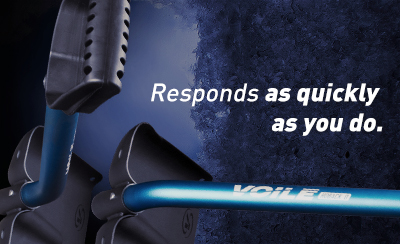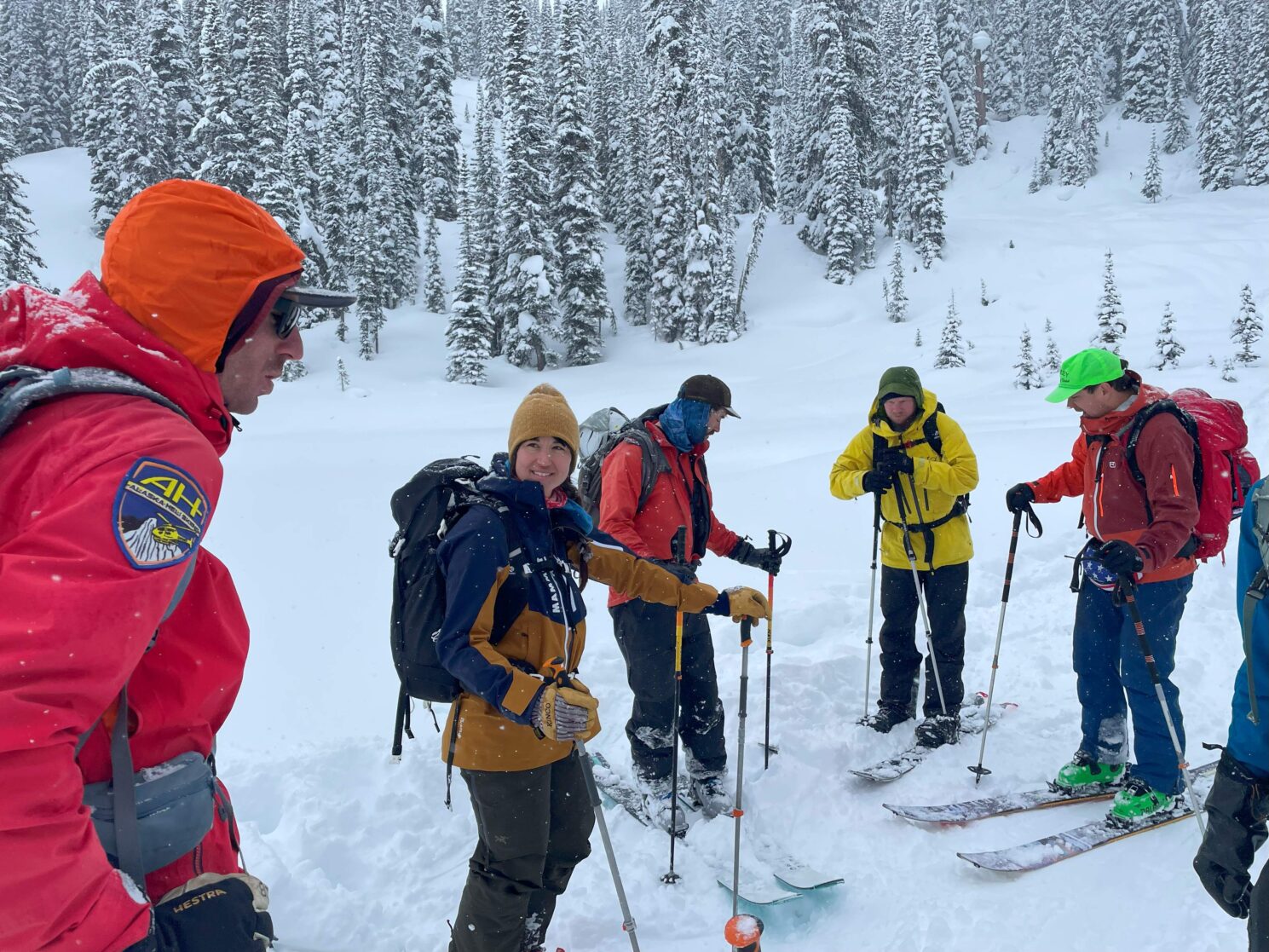
Seasons of the Ski Guide: Adapting to the Changing Backcountry
Share this Post
Working as a Ski Guide throughout a winter season encompasses a seasonal shift that essentially mirrors the snowpack as well as the seasonal life span of a recreational skier. I would break the seasons of the ski guide into four distinct chapters:
- Early or ‘education season’: Observation gathering, snowpack investigation, and winter holiday rush.
- Middle season: Skiing the bread and butter, working with return clients, and continuing to cultivate new ones.
- Late season: “Openable” terrain gets larger, spring break rush, stability, and cold snow co-exist together (also some ski mountaineering can happen).
- 4th season: The season for big mountain roving and, specialized trips with specialized clients.
Hopefully, this post works in two ways. To inspire folks who are looking for more mentorship in backcountry skiing to hire a guide, and to help inspire guides looking for new pathways of income to expand their horizons.
Lastly, this is the perspective of a ski guide who primarily works in either a continental or intermountain snowpack. PNW guides might have a different perspective on their seasonal shift 😉
The early season: December 15th – February 1st
Where I live in SW Montana, a lot of our permitted backcountry skiing zones don’t generally have enough snow for quality skiing until at least late December. However much I would love to book clients at the beginning of the month, it’s hard to sell someone on a day when, after it’s all said and done, they aren’t sure the core shots justified the price of the guide.
Since business is low and most people are getting reacquainted with backcountry skiing anyway, teaching several avalanche courses early in the season usually fits the bill for keeping the paychecks coming. Additionally, getting paid to dig a bunch of snow pits and getting eyes on permitted terrain will help you in the coming months to deliver safer and higher reward days. I do everything I can to maintain relationships with students and hopefully get them excited about private guided days down the road.
The early season plays a crucial role in shaping the seasons of the ski guide, from building relationships to preparing for the demands of midwinter. Lastly, I can usually bank on the 10 days surrounding Christmas to provide a reliable bump in private guided days booked. Even though this can be welcomed income, conditions can be tricky. Going higher in elevation is almost always necessary, requiring higher levels of client fitness.
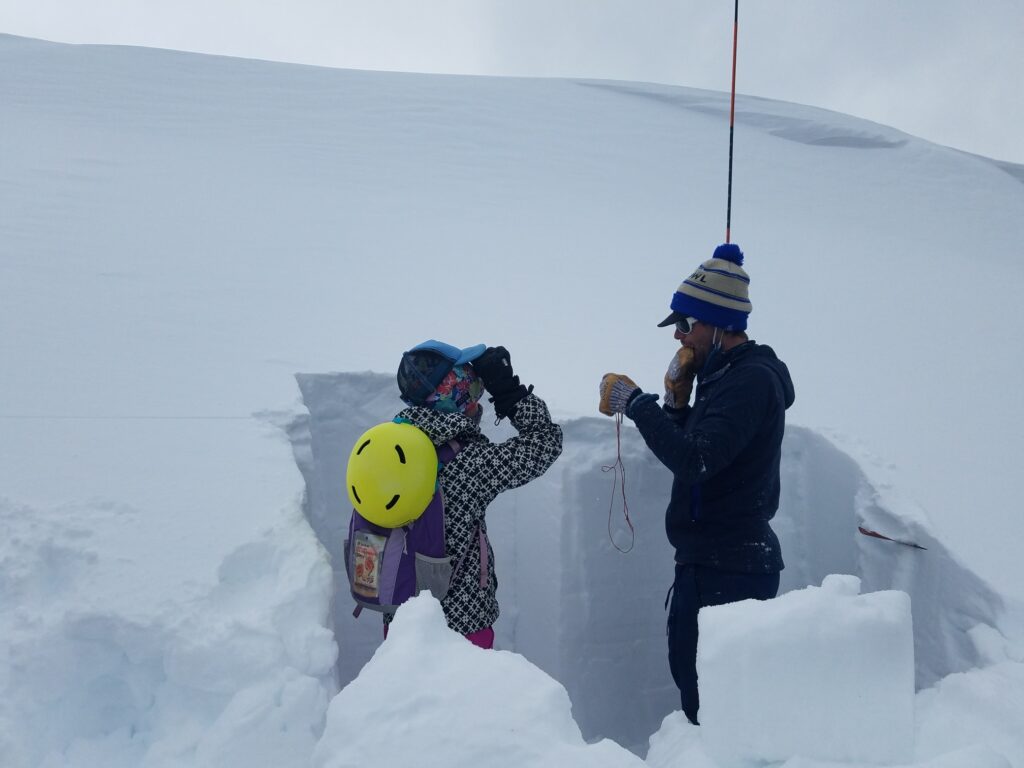
Weather: Long nights, cold temps, and shallow snow is ripe for laying down the weak early-season snow we count on in the Rockies.
Snowpack: Shallow, weak, untested. This snowpack needs to prove its worth before it can be trusted.
Main Avalanche problems: Persistent weak layers (PWL), facets on logs.
Early season specialized gear:
- Pit digging shovel – Flat blade, hoe mode, large volume capacity. The Voile Hoback D is the Clydesdale of the fleet that’s best for this type of work.
- Snow saw – I don’t always carry one, but I do when PWLs are present in the snowpack. If you don’t always carry a snow saw, check out the Voile T-Wood Avalanche shovel (there’s a saw hidden in the handle).
- Snow study kit- Rarely do I use a loupe, but when teaching, it comes in handy.
- Extra layer/puffy pants – Standing around in snow pits talking about extended column tests can be cold. Norrona Lyngen 850 Down Knickers are an excellent balance of added warmth and weight consideration.
- Water bottle parka – Sometimes it’s so cold your water bottle freezes, pro tip: Don’t let that happen. Forty Below Bottle Boot is my pick.
- Toe warmers or heated socks – Lenz heated socks are becoming the go-to for industry professionals.
- Thermos for hot liquids – Mmmm yes 😉
Middle season: February 1st – Late March
This is the two(ish) months of peak season in the Rocky Mountains. The middle season consists of the standard bread and butter work of serving up the pow. Operational observations are building, knowledge of the seasonal snowpack is becoming better, and your openable terrain grows from both a threshold perspective (enough snow) and a stability perspective. For many, this period defines the heart of the seasons of the ski guide. This would be the two real months of cold snow guiding that sometimes so good and easy, its even hard for guides to mess up. Booking return clients during the middle of February is usually the best way to ensure you can deliver a quality product.
With the arrival of March comes the beginning of the big line season. With slightly longer days and a deeper snowpack, the prized lines begin to become a possibility. Additionally, spring break for the kids generally means folks are out on ski vacations looking to get into the terrain they dream about all year. This is the season of guiding to make their dreams come true.
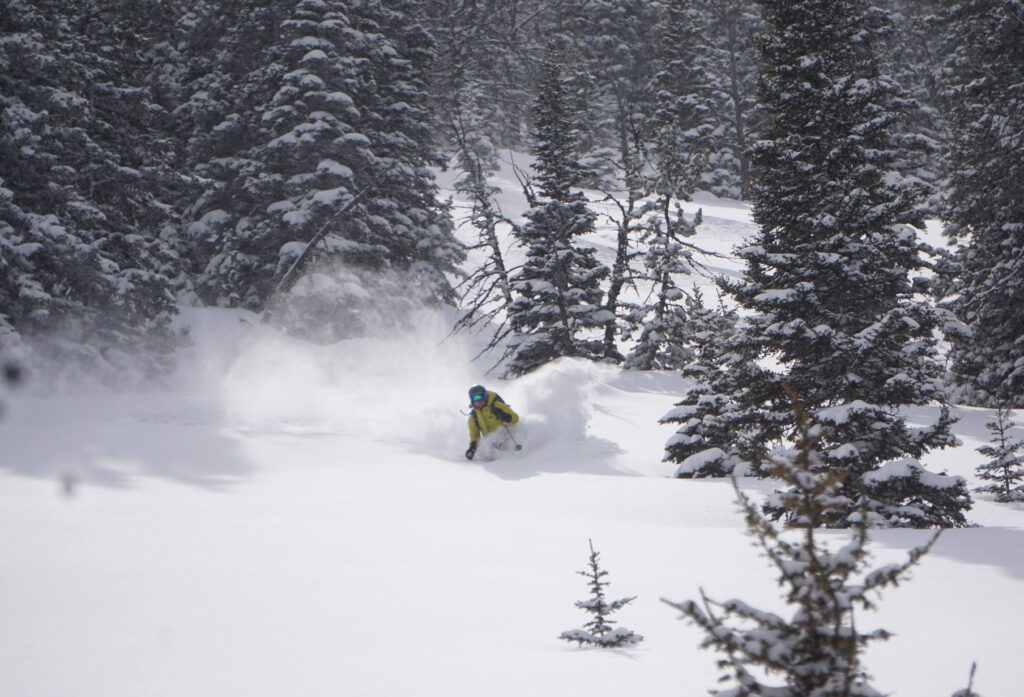
Weather: Ever-lengthening days with bouts of heavy snowfall.
Snowpack: Usually 1-2 meters of snow on the ground, a variety of snowpack structures that carry the most complexity of the season. Avalanche activity with changes in the weather, PWL re-activating with storm events with 1”< SWE.
Main Avalanche Problems: New snow instabilities and Persistent weak layers.
Middle season gear:
- Everyday shovel – Light but digs a pit. Flat blade, hoe mode. Voile Hoback TM Mini works great.
- Snow saw – I usually still have it with me at this time.
- Aprés bevies for TH – La Croix have been popular amongst clients lately.
Late season: Late March – May 1st
Spring powder and full skimo lines! Lower elevation town levels start to melt out, high peaks are still getting buried, and stability is the best it will ever be. The late season represents a pinnacle of opportunity in the seasons of the ski guide, combining stability and exciting terrain for the most ambitious clients. Do you want to ski pow and corn on the same day? Check. Do you want to wear flip-flops at the Trailhead while celebrating with an Aprés bevy? Check. Do you want to center-punch avalanche terrain without worrying if you are going to trigger a monster avalanche? Check. It turns out you can have your cake and eat it too! This is my favorite time of year to both work and recreate in but unfortunately for most folks, they are starting to think about other things. Mountain biking anyone?
Throughout the main part of the winter, I like to remind clients that spring is actually the best season and try to get them excited about trips to the high peaks in the later months. Tetons, Beartooths, Alaska… these are the places I like to go as well as sell clients on. For someone like me who can’t think of much else besides skiing… the late season is where my dreams come true.
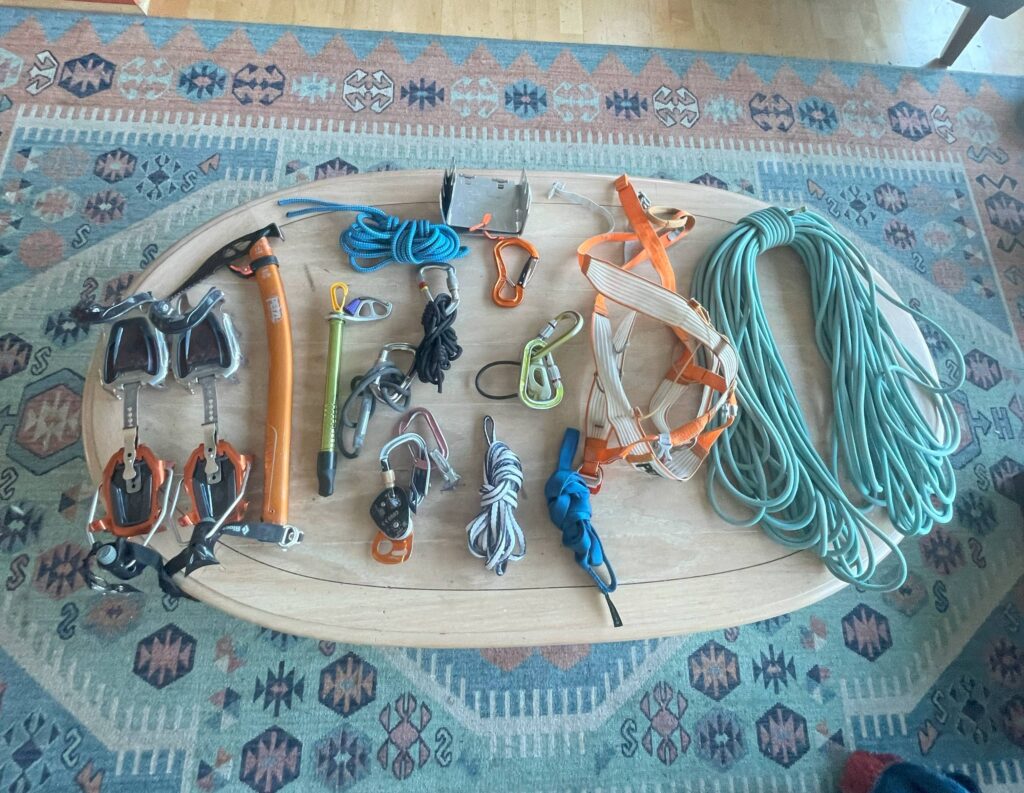
Weather: Periods of heavy snowfall intermixed with periods of above-freezing temps.
Snowpack: 2-4 meters in the high country, crusts especially on solar aspects, generally deep, stable, and have a variety of surfaces for new snow to slide on. Old, mature, PWLs can be reactivated with prolonged non-freezing temps.
Main Avalanche problems: New snow instabilities, wet avalanches, and dormant, deep PWL.
Late-season gear:
- Light shovel – As light as a real shovel I can find. Voile XLM is a good pick.
- Crampons – I like a “mullet” setup. business in the front (steel), and party in the back (aluminum). Check out the Blue Ice Harfang automatic and semi-automatic. Unfortunately for me as a tele-skier, finding the correct toe bail for crampons is tough. I mostly stick to semi-automatic crampon setups which almost always work with an NTN boot.
- Ice axe – Petzl Gully with a hammer for placing pitons is usually the one tool to rule them all! Add pick weights if you’re going to be swinging into some real ice. For especially dry conditions or harder ice climbing, the Blue Ice Akila is a good choice.
- Rope – Short roping? Lowering? Rappelling? Glacier travel? 40m of RAD line will take care of you. Unfortunately, my favorite rope only comes in 30m and 60m, so chopping a 60m to 40m is an expensive, albeit worthwhile sacrifice for the weight/usability ratio. Vela Sailing Supply also sells the Marlow Excel R8 rope (5mm) that has come into vogue as a rappel line, made popular by the Teton crowd. Not rated for anything other than sailing… user discretion is advised. Lastly, the Beal Backup Line is a good and cheaper substitute for the Rad line that comes in a variety of lengths. It is not rated for true roped glacier travel, so that is one limitation.
- Beal Escaper – A new standard in ski mountaineering that allows one to rappel on a single strand and still retrieve it from the bottom. Best for steep single rappels.
- Ski harness- The lighter the better. I like the Petzl Altitude. Arc’teryx LEAF is another favorite of mine if you are okay without leg loops. Caveat: this harness may be challenging to get a hold of as proof of government or military employment will be required to purchase one.
4th season: May – June
Skiing in May? June?! If you thought selling ski trips in April was hard… May and June are a whole other story. The final chapter of the northern hemisphere year narrows to select destinations for select clients. For guides in the PNW, May and even June trips are a reasonable sell. Volcanoes are still full of snow, and the milder temps make visiting the high peaks somewhat appealing.
For a ski guide in the Rockies, I must look further afield for something that is appealing to clients. Iceland, Norway, or select local high-peak venues are what I focus on for the dwindling days of the snow year. This is the time to have a full list of local clients, so when it dumps in the middle of May, you can go ski the line you want to get on and have your client see what the fuss is about.
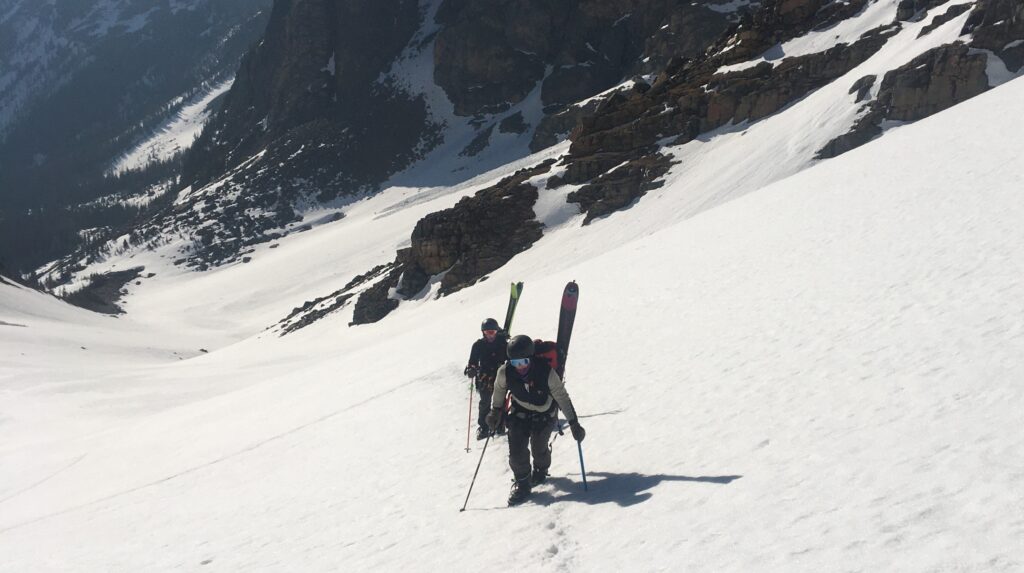
Weather: Spring diurnal, or extended periods of non-freezing. Occasional snow events usually avalanching on mature crusts.
Snowpack: Deep consolidated rounded grains that are generally stable.
Main avalanche problems: Wet snow avalanche problems, cornices.
4th season gear:
- Light shovel – Voile XLM
- Lightweight shelter – For getting into hard-to-reach places, overnights might be the only way to go. Black Diamond Mega Light mid has been my go-to for 15 years. There are now many other options, including simply using a rescue sled as a tarp. Check out Apocalypse Gear’s Ski Guide Rescue Sled, or Alpine Threadworks’ offering.
- Bikes – For forest service roads are still closed to cars. E-bikes too.
- Running shoes – For dirt approaches.
- Passport – Flights to Iceland can be cheap…
Bonus seasons of the ski guide!
Beyond the standard 4 seasons in the Intermountain Rockies, there are many other seasons of the ski guide that are worthwhile to check out, be a part of, or sell your clients on for a chance to go there yourself.
PNW volcanoes: May – June with a huge population center full of people looking to hire ski guides.
Iceaxe Expeditions: Running trips to Antarctica during the second half of October. It’s always tough to find fall work in the American guiding scene. This could be a good way to fill your schedule.
Japan guiding season: January can be tough here in the States, it’s generally pretty good in Hokkaido at that time.
Alaska Heli season: Early March – May 1st. It might not pay great to be a heli guide, but it can be a great way to get tipped well and meet a lot of clients.
Iceland Heli and touring season: Early March – June 15th. The latest northern hemisphere season I can think of.
Greenland boat access: Best in April to access the snow from the ocean while still having spring snowpack and temps.
Alaska range basecamp: Car camping from an airplane… the best way to spend your April.
New Zealand spring: August – September is best for the main ski season, big mountain skiing season is generally best in October.
Chile/Argentina: September is best depending on what you are doing.
Wrapping it all up
To conclude this discussion, I would like to highlight a few important points to help everyone find success and fill your schedule as a ski guide.
- Build and update an arsenal of gear that specifically trailers to each season and application of guiding. Unfortunately guiding can be expensive, but the more credentialed you get, the better you can navigate the world of discounted gear. Below is a list of my daily drivers that are consistent almost every day.
- Voile CamLock 2 Carbon Ski Poles. With extra baskets for the repair kit. A truly light touring pole with the most useful backcountry tool already attached: The scraper. Useful for heel risers and 22 Designs Lynx telemark bindings as well.
- Voile Guide Avalanche Probe 320. This probe is truly Simple. Solid. Backcountry. Sometimes I’ll use the 260, but generally think that 300+ cm is better for professional use.
- Apocalypse Gear SaC.Ski pack with minor customization on ski carry and ice axe sleeve. Simple, bulletproof, and carries like I am wearing a freeride vest, not a backpack.
- Apocalypse Gear Ski Guide Rescue Sled. I wish I didn’t have to carry one, but this is light enough you will always have it in your pack.
- An assortment of Voilé Straps for all sorts of reasons: fixing pesky skin tails, fixing broken boots, or missing buckles. Rigging a ski carry on client’s packs, the list goes on and on.
- Secondly, Find ways to market yourself. Maintain a website, hand out business cards, and make a concerted effort to work with the referrals you get from other guides. You will have to be proactive and a little stubborn to get the private client list you want
- Hold on to the contacts of every client you encounter, and make notes about their abilities, how much they tipped, and ideas for what might be fun to sell them on in the future.
Lastly, go skiing! Make sure you spend the time recreating in the mountains that you want to guide. Having a track record throughout the year(s) helps you sell trips with higher confidence and better success. If you know a good storm cycle is coming and you have been keeping track of what is going on in the snowpack, chances are that local private clients will be more likely to say yes if they know you have been out there skiing all season long.
About The Author
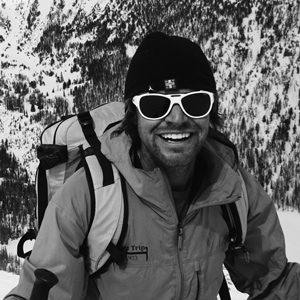
Location: Bozeman, MT
Skis: V8 186cm / Charger Ace 178cm
Website: www.TelemarkTy.com
Instagram: @ty.guarino
Ty is a career Mountain Guide and Ski Patroller currently working for Exum Mountain Guides, Beartooth Mountain Guides, Montana Mountaineering Association and Bridger Bowl Ski Patrol. He is the only active American IFMGA Mountain Guide working solely on Telemark gear. Originally from southern New Hampshire, Ty developed his passion for Backcountry skiing on the eastern flanks of Mt Washington in New Hampshire’s Presidential range. Currently Residing in Bozeman Montana, Ty skis as much as possible in and around the greater Yellowstone ecosystem. Although Bridger Bowl is his home mountain, Ty likes to explore other skiing venues including Alaska, South America, New Zealand, and New England.
Share this Post



